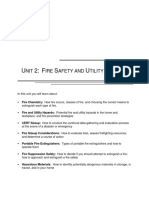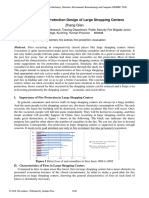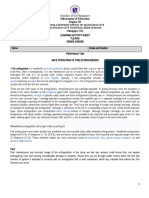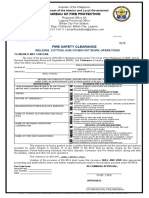13soc319 Escobedo
13soc319 Escobedo
Uploaded by
Vernie EscobedoCopyright:
Available Formats
13soc319 Escobedo
13soc319 Escobedo
Uploaded by
Vernie EscobedoOriginal Title
Copyright
Available Formats
Share this document
Did you find this document useful?
Is this content inappropriate?
Copyright:
Available Formats
13soc319 Escobedo
13soc319 Escobedo
Uploaded by
Vernie EscobedoCopyright:
Available Formats
PNTC COLLEGES
Zone III, Lt. Cantimbuhan St. Poblacion, Dasmariñas City
ACTIVITY SHEET
Name ESCOBEDO, VERNIE D. Year and Section MT-NPBST32-A1
Course Code SOC 319 Course Title Social Science and
Philosophy(Includes PADAMS,
Occupational Health & Safety)
Module Number MODULE 13 Content Topic Fire Safety: Meaning, Fire
Protection, Hazard Control, Fire
Point, Fire Extinguisher, Classes
of Fires, Fire Fighting Equipment,
Fire Fighter, Fire Hose, Fire
Precaution
Teacher Mr. De La Torre Date June 21, 2022
PART 1. EVALUATE
1. What is fire safety?
Answer
Refers to planning and infrastructure design aimed at reducing the risk of fire or impeding the spread of a fire
when one does break out. Fire safety encompasses the use of fire-resistant building materials, preventative
actions, safe work practices, fire safety training, flame-resistant protective clothing, and more
2. What is does NFA stand for?
Answer
National Fire Academy
3. What is fire mean?
Answer
Combustion occurs when a material is ignited and mixed with oxygen, resulting in fire. Light, heat, and a
visual appearance such as orange or yellow flames are produced as a result.
4. What are the different fire protections?
Answer:
Implementing safety planning practices and drills
Providing education on fire risks and safety
Conducting research and investigations
Safety planning
Fire-resistant building construction materials and practices
Safe operations
Training and testing of mitigating systems
5. What are the different hazard controls?
Answer:
1. Elimination: This involves elimination of the hazard. It is the most effective measure, but may not always
be possible. For example, working at heights may be a required part of some jobs.
2. Engineering Controls: This involves modifying the plant or equipment so that the associated hazards are
reduced. For example, a plant might add a ventilation system.
Form No. BPM2-CME 20 F-010
Rev.00
PNTC COLLEGES
Zone III, Lt. Cantimbuhan St. Poblacion, Dasmariñas City
3. Administrative Control: This involves changing the way in which a particular type of work is carried out.
This is achieved by changing the timing of the work and/or changing policies and procedures.
4. Personal Protective Equipment (PPE): This is considered a last resort for employee protection for when
other controls fail. It includes things like helmets, eye protection and safety footwear and while it is helpful, it
is the least effective control in the safety hazard control hierarchy.
6. What are the different classes of fire?
Answer
Class A Fire A class A fire refers to a fire that involves solid combustibles such as wood, coal, paper, plastic,
straw, cloth, rubber or any other solid material. These solid substances are mainly of organic origin and
contain carbon and its compounds.
Class B Fire Class B fire refers to a fire involving flammable liquids such as petroleum (gasoline, kerosene,
petrol, diesel, octane, etc.), paint, alcohol, solvent, oil and tar, etc. that normally do not leave any embers or
residues (or very low amounts of residues). Most of these liquids have a high carbon content and the
compounds in them and are highly combustible.
Class C Fire A class C fire refers to a fire that involves flammable gases such as natural gas, petroleum gas,
butane, hydrogen, acetylene or propane. These gases are highly combustible and may cause large scale fires
and explosions if mixed with enough oxygen.
Class D Fire A class D fire refers to a fire that involves in burning of some extraordinary metals such as
sodium, magnesium, aluminum, potassium, lithium, titanium, zirconium and some of their alloys.
Class D Fire A class D fire refers to a fire that involves in burning of some extraordinary metals such as
sodium, magnesium, aluminum, potassium, lithium, titanium, zirconium and some of their alloys.
PART 2. EXTEND
1. Why safety precaution is necessary?
Answer
For them to know the other risk that may come upon. And for them to properly plan the things must do in
eliminating fire for the safety of the civilians around the area.
2. Who can give fire safety training?
Answer
Fire Fighter, Professional fire fighters of the government and other public services are highly trained, wear
special personal protective equipment and gear and use special vehicles and equipment. A fire fighter is a
person or employee who fights and extinguishes fires. This individual has theoretical and practical knowledge
about procedures by which to extinguish fires using the correct type of extinguishers or other appliances.
3. Why is fire safety education and training important?
Answer
It is important for people because to avoid panic and thru ignorance of what must right thing to do will
jeopardize others because of that. Thru that we can help to eliminate or lessen the damage that may cause by
fire if we are knowledgeable upon proper actions in case of fire in the area.
Form No. BPM2-CME 20 F-010
Rev.00
PNTC COLLEGES
Zone III, Lt. Cantimbuhan St. Poblacion, Dasmariñas City
Form No. BPM2-CME 20 F-010
Rev.00
You might also like
- FOE ReviewerDocument91 pagesFOE ReviewerRamon Chito Pudelanan93% (215)
- FireManual2015 PDFDocument545 pagesFireManual2015 PDFanon_49126960086% (14)
- GO Ms No-86Document31 pagesGO Ms No-86anikenskyywalker100% (7)
- ICBO Mechanical Code-97Document185 pagesICBO Mechanical Code-97Matthew Taylor100% (1)
- OLP 2022 Revised GuidebookDocument160 pagesOLP 2022 Revised Guidebookwawangpulo firestation100% (2)
- Fire Loss Control: Who Is The Key Man in An Effective Fire Loss Control Program? Why?Document10 pagesFire Loss Control: Who Is The Key Man in An Effective Fire Loss Control Program? Why?hendrexNo ratings yet
- Utilities Module 2Document27 pagesUtilities Module 2Celinni DasigNo ratings yet
- 2.3 Emergency Fire Safety Sedex Supplier WorkbookDocument12 pages2.3 Emergency Fire Safety Sedex Supplier WorkbookAnirban Sikder100% (1)
- Inspection Guide For Fire Inspection & AuditsDocument37 pagesInspection Guide For Fire Inspection & Auditssai kiran100% (1)
- CFPPDocument22 pagesCFPPKhirstenLyrioCalayag100% (3)
- Foe ReviewerDocument57 pagesFoe ReviewerJoey CelesparaNo ratings yet
- Fy11 sh-22248-11 Fire ExtinguisherDocument51 pagesFy11 sh-22248-11 Fire ExtinguisherMuzaffar RiazNo ratings yet
- Fire ExtinguisherDocument51 pagesFire ExtinguisherStephen AnoffNo ratings yet
- Incipient Stage Fire Extinguisher Education OSHA 1910.157 (G)Document51 pagesIncipient Stage Fire Extinguisher Education OSHA 1910.157 (G)Siduzzaman Khan SourovNo ratings yet
- Fy11 sh-22248-11 Fire ExtinguisherDocument51 pagesFy11 sh-22248-11 Fire ExtinguisherAbdulrahman JradiNo ratings yet
- Case Study 2 June 2020Document5 pagesCase Study 2 June 2020MuhammadBinHanifNo ratings yet
- Foe ReviewerDocument57 pagesFoe ReviewerJoey CelesparaNo ratings yet
- Mechanical Engineering DepartmentDocument20 pagesMechanical Engineering DepartmentAiril AizanNo ratings yet
- File 1 Fire Suppression 30%Document8 pagesFile 1 Fire Suppression 30%juan delacruzNo ratings yet
- MANDocument25 pagesMANCO - 46 - Vaishnavi SableNo ratings yet
- FOE ReviewerDocument89 pagesFOE Reviewerjuan delacruzNo ratings yet
- Basic Occupatio Nal Safety & HealthDocument8 pagesBasic Occupatio Nal Safety & HealthHurty James DayonNo ratings yet
- Fire Loss ControlDocument18 pagesFire Loss ControlAriel AlcantaraNo ratings yet
- Osha AssignmentDocument5 pagesOsha Assignmentandersonambing05No ratings yet
- Handbook Educational Buildings EngDocument48 pagesHandbook Educational Buildings EngKero IbraheemNo ratings yet
- Sbtet Project FireDocument46 pagesSbtet Project FireKiran Kumar Damurothi100% (1)
- 021 Procedure Fire ProtectionDocument15 pages021 Procedure Fire ProtectionHSE CERINo ratings yet
- Symph Ens orDocument72 pagesSymph Ens orANTONIO COBALLESNo ratings yet
- Efdt Met 7 - DRRR - CerbitoDocument4 pagesEfdt Met 7 - DRRR - CerbitoJohn Vincint CerbitoNo ratings yet
- Fire Safety Model in Brgy. II-B San Pablo City: Presented To The Faculty of Senior High SchoolDocument5 pagesFire Safety Model in Brgy. II-B San Pablo City: Presented To The Faculty of Senior High Schoolkinginsamo part whad sNo ratings yet
- Module 3 Fire Prevention and ProtectionDocument4 pagesModule 3 Fire Prevention and ProtectionDanish ShaikhNo ratings yet
- PROPOSAL Mugim WPS Office-1Document8 pagesPROPOSAL Mugim WPS Office-1Mugim 12345No ratings yet
- Tyif ManDocument10 pagesTyif Manvsslondhe13No ratings yet
- PG Diploma SafetyDocument8 pagesPG Diploma SafetynijithNo ratings yet
- Case Study2 (Fire Safety) OSHADocument18 pagesCase Study2 (Fire Safety) OSHAHazreen HazwanyNo ratings yet
- Handbook Hospital Building 6Document52 pagesHandbook Hospital Building 6lillyNo ratings yet
- Unit-3 Fire Protection Management SystemDocument15 pagesUnit-3 Fire Protection Management Systemshubhanshu.shopatoneNo ratings yet
- FIRE Protection SystemDocument17 pagesFIRE Protection SystemPrashansa BhattaNo ratings yet
- Co-Requisite: Prerequisite: Data Book / Codes/Standards Course Category Course Designed by ApprovalDocument3 pagesCo-Requisite: Prerequisite: Data Book / Codes/Standards Course Category Course Designed by Approvalrajkumar rNo ratings yet
- Case Study 2 UpdatedDocument3 pagesCase Study 2 Updateddeandradawkins07No ratings yet
- Explosives Manuscript 1Document8 pagesExplosives Manuscript 1mesaclethNo ratings yet
- FIRE PREVENTION BASICDocument14 pagesFIRE PREVENTION BASICkshb29msyqNo ratings yet
- Fire Risk Assessment and Fire Load Calculation in Manufacturing IndustryDocument12 pagesFire Risk Assessment and Fire Load Calculation in Manufacturing IndustryAnonymous M4BGwOkIpNo ratings yet
- Fire Safety and Fire CodeDocument10 pagesFire Safety and Fire CodeRaquel PanillosNo ratings yet
- Handbook Industrial Buildings EngDocument52 pagesHandbook Industrial Buildings EngWirawan Adi Setya RNo ratings yet
- Fire Risk Assessment-Computer SainsDocument81 pagesFire Risk Assessment-Computer SainsMuhammad IqbalNo ratings yet
- ESSAY On FireDocument7 pagesESSAY On FireguruNo ratings yet
- Fire Protection SystemsDocument12 pagesFire Protection Systemsaykyo333No ratings yet
- Uca - bst.f.2019.18 (Assingment 01)Document2 pagesUca - bst.f.2019.18 (Assingment 01)shehan harshithaNo ratings yet
- Fire Science Test Prep FTEC 106Document273 pagesFire Science Test Prep FTEC 106pointernoobNo ratings yet
- CERT IG Unit2 Jan2011Document62 pagesCERT IG Unit2 Jan2011Pc KumaranNo ratings yet
- Study On Fire Protection Design of Large Shopping Centers: Zhang QianDocument4 pagesStudy On Fire Protection Design of Large Shopping Centers: Zhang QianMicah CarmonaNo ratings yet
- Conference Paper For 2018 JournalDocument8 pagesConference Paper For 2018 JournalSaidu NingiNo ratings yet
- Southeast University: Dept. of Textile EngineeringDocument8 pagesSoutheast University: Dept. of Textile EngineeringRifa TasniaNo ratings yet
- Complete Foe ReviewerDocument83 pagesComplete Foe Reviewerfernandodiazjr03No ratings yet
- Fire Safety MeasuresDocument15 pagesFire Safety MeasuresCrisostomo IbarraNo ratings yet
- 3172426Document2 pages3172426Khushal BhalwalaNo ratings yet
- Examining Fire Protection Methods in The Data Center Transcript-SHDocument14 pagesExamining Fire Protection Methods in The Data Center Transcript-SHTOPS LUKAMBONo ratings yet
- Agricultural Technology Grade 10 Term 1 Week 4Document5 pagesAgricultural Technology Grade 10 Term 1 Week 4louis.clensieNo ratings yet
- Monographs FireDocument34 pagesMonographs Firedebabrata duttaNo ratings yet
- Performance Task Fire ExtingisherDocument4 pagesPerformance Task Fire ExtingisherTimbas, Raizel DeeNo ratings yet
- FIRE DETECTION AND RESPONSE SYSTEM EditedDocument34 pagesFIRE DETECTION AND RESPONSE SYSTEM EditedKenneth CabebeNo ratings yet
- Element 10 - Learner JournalDocument5 pagesElement 10 - Learner Journaldivyamchoudhary49No ratings yet
- 6soc319 EscobedoDocument2 pages6soc319 EscobedoVernie EscobedoNo ratings yet
- 9soc319 EscobedoDocument3 pages9soc319 EscobedoVernie EscobedoNo ratings yet
- 5soc319 EscobedoDocument3 pages5soc319 EscobedoVernie EscobedoNo ratings yet
- 8soc319 EscobedoDocument3 pages8soc319 EscobedoVernie EscobedoNo ratings yet
- 3soc319 EscobedoDocument4 pages3soc319 EscobedoVernie EscobedoNo ratings yet
- 1soc319 EscobedoDocument2 pages1soc319 EscobedoVernie EscobedoNo ratings yet
- 2soc319 EscobedoDocument2 pages2soc319 EscobedoVernie EscobedoNo ratings yet
- 12soc319 EscobedoDocument3 pages12soc319 EscobedoVernie EscobedoNo ratings yet
- 14soc319 EscobedoDocument3 pages14soc319 EscobedoVernie EscobedoNo ratings yet
- Bull Ring White Duck Uniform and PicturesDocument10 pagesBull Ring White Duck Uniform and PicturesVernie EscobedoNo ratings yet
- 11soc319 EscobedoDocument2 pages11soc319 EscobedoVernie EscobedoNo ratings yet
- 13.week13 Sea204b2 EscobedoDocument5 pages13.week13 Sea204b2 EscobedoVernie EscobedoNo ratings yet
- Mod Nav 306b 1 r.3Document19 pagesMod Nav 306b 1 r.3Vernie Escobedo100% (1)
- Banking and Insurance Law ProjectDocument18 pagesBanking and Insurance Law ProjectShubhangi AgarwalNo ratings yet
- Rule 10. Fire Safety Measures Chapter 1. CoverageDocument167 pagesRule 10. Fire Safety Measures Chapter 1. CoverageARIEL LIOADNo ratings yet
- Max Control 7465195 enUS Om 07-22Document52 pagesMax Control 7465195 enUS Om 07-22hsseo7777No ratings yet
- SMOKE CONTROL SYSTEM IN HIGH RISE BUILDINGS Rev1Document57 pagesSMOKE CONTROL SYSTEM IN HIGH RISE BUILDINGS Rev1Joshua FernandezNo ratings yet
- BRIGADA ASSESSMENT FORM AutosavedDocument8 pagesBRIGADA ASSESSMENT FORM AutosavedGrace Joy Iñon TajanlangitNo ratings yet
- LEC 2017 - Post-Test in Fire Technology & Arson InvesDocument8 pagesLEC 2017 - Post-Test in Fire Technology & Arson InvesBokhary Dimasangkay Manok Elias100% (1)
- Building Construction (III) : "Fire Protection"Document31 pagesBuilding Construction (III) : "Fire Protection"cricket reviewNo ratings yet
- CBD Life Safety ReportDocument18 pagesCBD Life Safety Reportali faragallahNo ratings yet
- Nfpa Fire Safety ComplianceDocument9 pagesNfpa Fire Safety ComplianceharishNo ratings yet
- How To Achieve Zero AccidentDocument108 pagesHow To Achieve Zero AccidentAjit BhosaleNo ratings yet
- Assessment 4Document49 pagesAssessment 4jellaflorian100% (1)
- NABH ChecklistDocument3 pagesNABH ChecklistMargretSneha100% (2)
- Jethro Quiocho - q4 Activity 3 Fire HazardsDocument4 pagesJethro Quiocho - q4 Activity 3 Fire HazardsJethro QuiochoNo ratings yet
- Sampangan Duta Pancasakti Textile, PT - SR (2022)Document27 pagesSampangan Duta Pancasakti Textile, PT - SR (2022)NasrullahNo ratings yet
- 51 Fire Safety Act & RegulationsDocument92 pages51 Fire Safety Act & RegulationsVimal FranklinNo ratings yet
- Fire Risk Assessment FormDocument20 pagesFire Risk Assessment FormAhmed Ibrahim100% (1)
- NFPA Fire Protection Handbook 2003 19th Edition Nfpa All Chapter Instant DownloadDocument66 pagesNFPA Fire Protection Handbook 2003 19th Edition Nfpa All Chapter Instant Downloadmralitfy100% (2)
- Appendix 6 THESISDocument3 pagesAppendix 6 THESISShaira Jane Villareal AlcantaraNo ratings yet
- 351 SU3 Plan WSH Monitoring Program - 2023Document55 pages351 SU3 Plan WSH Monitoring Program - 2023Pavalamani PeriasamyNo ratings yet
- TH3s1s SampleDocument31 pagesTH3s1s SampleLimuel Milo LebiosNo ratings yet
- Group 1 Final Report Arson SubDocument70 pagesGroup 1 Final Report Arson SubDinoBeringuelNo ratings yet
- DRRR-Student Guide - LM8Fire Hazards-2022Document18 pagesDRRR-Student Guide - LM8Fire Hazards-2022dustinosugodNo ratings yet
- 30 FSED 34F Fire Safety Clearance For Hot Works Operation Rev02Document2 pages30 FSED 34F Fire Safety Clearance For Hot Works Operation Rev02Trash 2No ratings yet






































































































